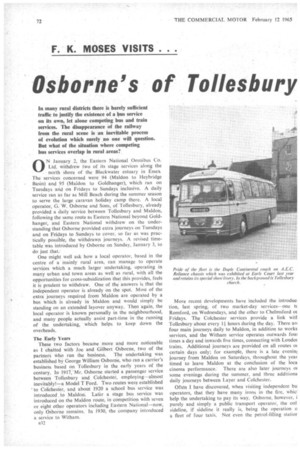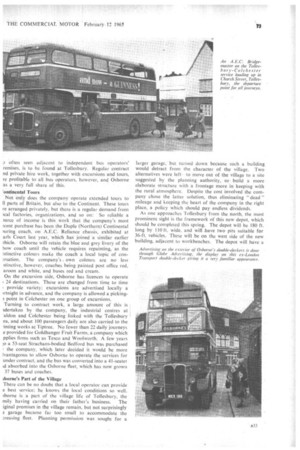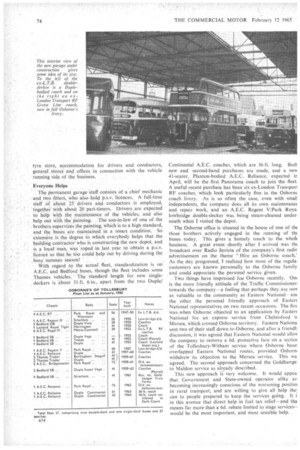F. K. MOSES VISITS . . .
Page 74

Page 75

Page 76

If you've noticed an error in this article please click here to report it so we can fix it.
Osborne's of Tollesbury
In many rural districts there is barely sufficient traffic to justify the existence of a bus service on its own, let alone competing bus and train services. The disappearance of the railway from the rural scene is an inevitable process of evolution which surely no one will question. But what of the situation where competing bus services overlap in rural areas?
0 N January 2, the Eastern National Omnibus Co. Ltd. withdrew two of its stage services along the north shore of the Blackwater estuary in Essex The services concerned were 94 (Maldon to Heybridge Basin) and 95 (Maldon to Goldhanger), which ran on Tuesdays and on Fridays to Sundays inclusive. A daily service ran as far as Mill Beach during the summer season to serve the large caravan holiday camp there. A local operator, G. W. Osborne and Sons, of Tollesbury, already provided a daily service between Tollesbury and Maldon, following the same route as Eastern National beyond Goldhanger, and Eastern National withdrew on the understanding that Osborne provided extra journeys on Tuesdays and on Fridays to Sundays to cover, so far as was practically possible, the withdrawn journeys. A revised timetable was introduced by Osborne on Sunday, January 3, to do just that: One might well ask how a local operator, based in the centre of a mainly rural area, can manage to operate services which a much larger undertaking, operating inmany urban and town areas as well as rural, with all the opportunities for cross-subsidization that this provides, feels it is prudent to withdraw. One of the answers is that the independent operator is already on the spot. Most of the extra journeys required from Maldon are operated by a bus which is already in Maldon and would simply be standing on an extended layover anyway. Then again, the local operator is known personally in the neighbourhood, and many people actually assist part-time in the running of the undertaking, which helps to keep down the overheads.
The Early Years These two factors became more and more noticeable as I chatted with Joe and Gilbert Osborne, two of the partners who run the business. The undertaking was established by George William Osborne, who ran a carrier's business based on Tollesbury in the early years of the century. In 1917, Mr. Osborne started a passenger service between Tollesbury and Colchester, employing—almost inevitably!—a Model T Ford. Two routes were established to Colchester, and about 1920 a school bus service was introduced to Maldon. Later a stage bus service was introduced on the Maldon route, in competition with seven or eight other operators including Eastern National—now, only Osborne remains. In 1930, the company introduced a service to Witham.
n32
More recent developments have included the introduc tion, last spring, of two market-day services—one tt Romford, on Wednesdays, and the other to Chelmsford or Fridays. The Colchester services provide a link witl Tollesbury about every 11 hours during the day. There an four main journeys daily to Maldon, in addition to works services, and the Witham service operates outwards foul times a day and inwards five times, connecting with Londoi trains. Additional journeys are provided on all routes °I certain days only; for example, there is a late evenin journey from Maldon on Saturdays, throughout the year timed to leave Maldon at the conclusion of the loca cinema performance: There are also later journeys oi some evenings during the summer, and three additiona daily journeys between Layer and Colchester.
Often I have discovered, when visiting independent bu operators, that they have many irons in the fire, whic help the undertaking to pay its way. Osborne, however, i purely and simply a public transport operator, the onl sideline, if sideline it really is, being the operation o a fleet of four taxis. Not even the petrol-filling statior • ) often seen adjacent to independent bus operators' remises, is to be found at Tollesbury. Regular contract nd private hire work, together with excursions and tours, re profitable to. all bus operators, however, and Osborne as a very full share of this.
'ontinental Tours Not only does the company operate extended tours to El parts of Britain, but also-to the Continent. These tours
re arranged privately, but there is a regular demand from ieal factories, organizations, and so on: So reliable a )urce of income is this work. that the company's most !cent purchase has been the Duple (Northern) Continental mring coach, on A.E.C. Reliance chassis, exhibited at arls Court last year, which. has joined -a similar earlier !.hicle. Osborne will retain the blue and'grey livery of the how coach until the vehicle requires repainting, as the lstinetive colours make the coach a local topic of con:rsation. The company's own colours are no less .stinctive, however, coaches being painted post office red, aroon and white, and buses red and cream.
On the excursion side, Osborne has licences to operate ! 24 destinations. These are changed from time to time ■ provide variety; excursions are advertised locally a prtnight in advance, and the company is allowed a picking) point in Colchester on one group of excursions.
Turning to contract work, a large amount of this is idertaken by the company, the industrial centres at -aldon and Colchester being linked with the Tollesbury I ea, and about 100 passengers daily are also carried to the -kiting works at Tiptree. No fewer than 22 daily journeys e provided for Goldhanger Fruit Farms, a company which pplies firms such as Tesco and Woolworth. A few years ,$) a 53-seat Strachans-bodied Bedford bus was purchased 7 the company, which later decided it would be more lvantageous to allowOsborne to operate the services for under contract, and the bus was converted into a 41-seater id absorbed into the Osborne fleet, which has now grown 37 buses and coaches.
iborne's Part or the Village
There can be no doubt that a local operator can provide e best service; he knows the local conditions so well. ;borne is a part of the village life of Tollesbury, the mily having carried on their father's business. The iginal premises in the village remain, but not surprisingly
e garage became far too small to accommodate the :Teasing fleet. Planning -permission was sought for a
larger garage, but turned down because such a building would detract from the character of the village. Two alternatives were left— to move out of the village to a site suggested by the planning authority, or build a more elaborate structure with a frontage more in keeping with the rural atmosphere. Despite the cost involved the company chose the latter solution, thus eliminating "dead " mileage and keeping the heart of the company in the right place, a policy which should pay endless dividends.
As one approaches Tollesbury from the north, the most prominent sight is the framework of this new depot, which should be completed this spring. The depot will be 180 ft. long by 110 ft. wide, and will ,have two pits suitable for 36-ft. vehicles. These will be on the west side of the new building, adjacent to workbenches. The depot will have a tyre store, accommodation for drivers and conductors, general stores and offices. in ,connection with the vehicle running side of the business.
Everyone Helps
The permanent garage 'staff consists of a chief mechanic and two fitters, who also hold -p.s.v. licences. A full-time staff of about 25drivers and conductors is employed, fogether. with about 20 part-timers. Drivers are expected to help with the Maintenance of the vehicles, and also help out with the Painting. The son-in-law of one of the . brothers supervizes the painting, which is to a high standard, and the buses are maintained in a smart condition. So extensive is the degree fo. which everybody helps that the building contractor who is constructing the new depot, and is a local Man, Was -roped in last year to obtain a p.s.v. licence so that he too could help out by driving during the busy summer season! With regard to the actual fleet, standardization is on .A.E.C. and Bedford buses, though the fleet includes some Thames vehicles. The standard length for new singledeckers is about 31 ft. 6 in., apart from the two Duple/
Continental A.E.C. coaches, which are 36 ft, long. Both new and second-hand purchases are made, and a new 41-seater, Plaxton-bodied A.E.C. Reliance, expected in April, will be the first Panorama coach to join the fleet A useful recent purchase has been six ex-London Transpori RF coaches; which Took particularly fine in the Osborn( coach livery. As is so often the case,' even with small independents, the company does all its own maintenanc( and repair cvork, and an A.E.C. Regent V/Park Roya lowbridge double-decker was being steam-cleaned under neath when I visited the depot.
The Osborne office is situated in the house of one of tho three brothers actively engaged in the running of tit( buses today. This gives a homely touch to the vv-holc business. A great event. shortly. after 1-arrived was th( broadcast over Radio Invicta of the company's first radic advertisement on the theme "Hire an Osborne coach.' As the day progressed, I realized how most of the regulai customers are known personally to the Osborne family and could appreciate the personal service given.
Two things have impressed Joe Osborne recently. Oni is the more friendly attitude of the Traffic Commissioner towards the company—a feeling that perhaps they are nov as valuable to the community as Eastern National—am the other the personal friendly approach of Eastert National representatives on two recent occasions. The firs was,when Osborne objected to an application by Easter' National for an express service from Chelmsford ti Mersea, which crossed Osborne territory. Eastern Nationa sent two of their staff down to Osborne, and after a friendi: discussion, it was agreed that Eastern National would alloy the company to remove a 6d. protective fare on a sectioi of the Tollesbury-Witham service where Osborne buse overlapped Eastern National routes, provided Osborn+ withdrew its objection to the Mersea service. This wa agreed. The second approach concerned the Goldhange to Maldon service as already described.
This new approach is very welcome. It would apnea that Government and State-owned operator alike ar becoming increasingly conscious of the worsening positioi in rural transport, and are willing to give all help the can to people prepared to keep the services going. It i in this avenue that direct help in fuel tax relief—and tha means far more than a 6d. rebate limited to stage services— would be the most important, and most sensible help.






























































































































